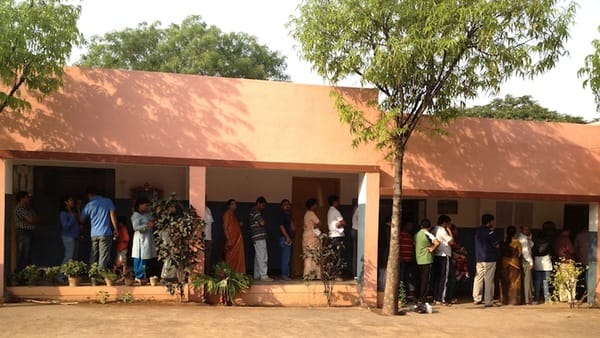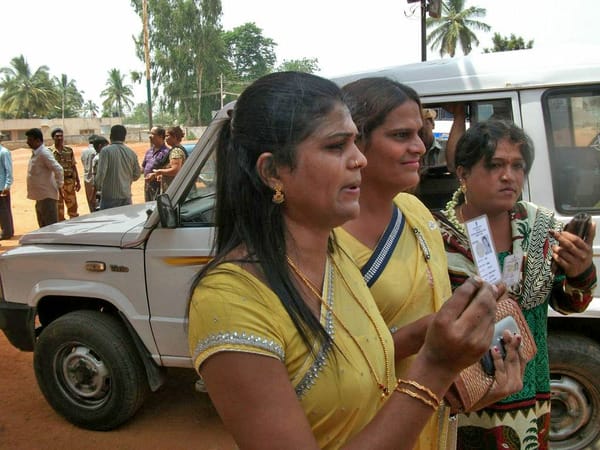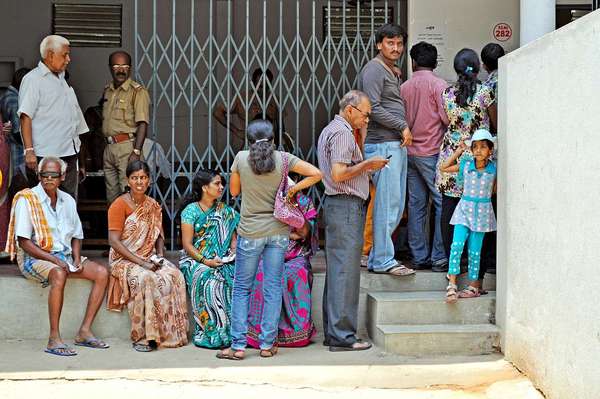It is perhaps the result of the persistent efforts of various civic groups to prompt people to vote. It might also be the increasing frustration among people about the lack of good governance. Whatever may be the reason, this election has proved different for Namma Bengaluru. The city recorded an overall 58.27% voter turnout in the assembly elections – a percentage unheard at least in last 10 years – a humongous 10% more than 2008 elections.

People queuing up at a polling booth in Whitefield early in the morning. Pic: Anantharaman R, Kadugodi resident.
Passion flows on the net, and into the booths
Online, nothing captured the enthusiasm to get out the vote better than a note on the Whitefield Rising Facebook group. Veerendra Mishra, the poster, a senior executive at a major MNC bank in the city exhorted residents of the massive Prestige Shantiniketan community to compete with residents of nearby communities in going out to vote.
“Heard from friends in Purva Fountain Square, Riviera, Rohan Vasantha, Palm Meadows and Brigade Metropolis that there are resident volunteers who are ferrying voters to polling booths. We cannot be left behind folks. We need to emerge victorious in this race to vote, come what may!”, wrote Mishra. Pleading with people to vote, Mishra even offered to help. “If anyone has transport problem, please give me a call… I shall ferry you to your booth… but please vote.”
“Intense Heat, long queues, other important stuff and all can wait for another day because this day will come again, only after 5 years”, he concluded, asking people to “fulfil your responsibility with pride”.
Tweeting was also furious througout the day. The #Bangalorevotes tag saw enthusiastic voters tweet-requesting people to get out and vote. The website tweetreach.com estimates that there were nearly a 1000 tweets using the #Bangalorevotes tag, reaching a possible 1,26,000 Twitter accounts. Leading amongst the tweeters was Rajya Sabha Rajeev Chandrasekhar.
Voter turnout for various constituencies
Comparison – Polling percentage in 28 constituencies – 2008 and 2013
| Constituency | 2013* | 2008 |
| 150Yelahanka | 66.71 | 61 |
| 151K R Puram | 59.06 | 43 |
| 152Byatarayanapura | 62.92 | 53.2 |
| 153Yeshwanthpur | 66.11 | 56.7 |
| 154Rajarajeshwari Nagar | 56.79 | 47.7 |
| 155Dasarahalli | 55.48 | 43.8 |
| 156Mahalakshmi Layout | 60.14 | 51.4 |
| 157Malleshwaram | 62.21 | 52.2 |
| 158Hebbal | 54.60 | 44.8 |
| 159Pulakeshinagar | 56.37 | 42.3 |
| 160Sarvagna Nagar | 50.23 | 35.4 |
| 161C V Raman Nagar | 53.90 | 40.6 |
| 162Shivajinagar | 54.30 | 47.9 |
| 163Shanthinagar | 57.74 | 44 |
| 164Gandhinagar | 57.38 | 44.1 |
| 165Rajajinagar | 61.03 | 52.6 |
| 166Govindrajnagar | 54.54 | 42.3 |
| 167Vijayanagar | 56.29 | 43.1 |
| 168Chamarajpet | 58.76 | 40.09 |
| 169Chikkpet | 57.90 | 47 |
| 170Basavanagudi | 52.21 | 42.5 |
| 171Padmanabhanagar | 58.38 | 52.9 |
| 172B T M Layout | 53.01 | 46.7 |
| 173Jayanagar | 55.82 | 47.1 |
| 174Mahadevpura | 61.57 | 53.1 |
| 175Bommanahalli | 54.81 | 44.3 |
| 176Bangalore South | 56.15 | 43.9 |
| 177Anekal | 68.74 | 58.5 |
| Average | 58.27 | 47.22 |
* To know the candidates contesting this time, click on the name of the constituency in the table.
The poll process has come to an end with better polling percentage than last assembly elections. However, the polling percentage in Bangalore could have been better, had the names of scores of voters not been missing from the list at the last moment.
Many people had to go back from the voting booths disappointed, as their names were not on the voter rolls. Many of those who could not vote had voted in previous elections from the same locality. These included pregnant women and elderly people, and sometimes entire families.
Somashekhar, a Jalahalli resident, checked the voters’ list in St Claret’s School polling station there, only to find that four of his family members could not vote. “We have always been staying in this area and have been voting. The names of my parents, brother and sister-in-law are not in the list,” he said, bewildered, after having checked the list multiple times.
Raghavendra Rao, a management committee member at the Chaithanya Samarpan layout in Kadugodi, had an agonising experience. He had applied on 6 December 2012 and received the Form 6 Acknowledgment from the www.votereg.kar.nic.in website the same day. He subsequently submitted an application on behalf of his wife Shaila, and got a similar acknowledgment.
On 24 February 2013, he received an SMS from the EC mentioning that his application had been approved for inclusion in the electoral rolls. Citizen Matters has a copy of this SMS. “The SMS, even gave the part number 52 for the Mahadevpura constituency. But I still did not find my name on the voter list when I checked before the elections”.

Transgender voters holding their EPICs. Pic: N Srinivasan
Since early March 2013, Rao kept searching repeatedly for their names in the voter lists uploaded on the website. On 29 April 2013, he finally found his wife’s name included in Part 52, but could not find his own. Rao then painstakingly searched for his name in the entire Mahadevpura constituency rolls, but with no success. “It’s a shame that such a callous attitude exists in the ‘software capital of the world’ as we Indians would like to believe”, he says.
Ironically, Rao had coordinated and facilitated the voter registration process for several others in the same community, all of whom got registered.
M V Suresh, a voter belonging to Bommanahalli constituency, said that both he and his wife could not vote, even though they had voted in the previous elections while staying in the same area. “I checked the web and found that my name was not in the voters’ list. We went to the booth anyway, but were not allowed to enter.” Suresh and his wife went to 6-7 booths nearby to check if their names had been mentioned in the voters’ list there, but the effort was futile.
Surekha Jagadish of JP Nagar said that her 21-year-old son Sai Sujaya J was unable to vote. “Six months ago we had given his details for the voters’ list, but there was no response. One month back, we met the BBMP ERO who told us that his name would be in voters’ list and he can vote. But when we went yesterday, his name was not there.”
Some voters at BET School, BEML Layout, III stage faced problem due to the wrong information provided on the electoral rolls. Nataraj, a voter, explained: “The names and numbers of people on the list do not match with those on the voter IDs. This indicates a serious mismanagement on the part of the officials and creates huge confusion”.
In many polling booths, initially Electronic Voting Machines did not function properly, resulting in heavy queue.
Malpractice attempted?
Some booth agents from Lok Satta party, who were sitting outside the poll booths, who wanted to remain anonymous, alleged that there were many irregularities and proxy voting in many areas. They claimed that a major party had cast proxy votes in JP Nagar when the apartment residents nearby had not turned up to vote. Raghavendra Kattimani, who was a Lok Satta booth agent in Oxford School, Jaraganahalli, said that police busted a group of about 30 people who were hiding in the basement of a temple close to the polling station. “They must have been hiding to cast proxy votes later. Police caught them, but we don’t know if any action was taken later,” he added.
Meanwhile as many as 85 people who were brought in a bus to a booth in Bommanahalli constituency were arrested by the police; 11 of them were retained whereas the rest were released.
Voters waiting in a booth near Kengeri Pic: Kedar Nadella
The callous attitude of the police was also visible. In St Claret’s School polling station in Jalahalli, the police allowed private vehicles to park right in front of the building while its occupants went to vote. But the same courtesy was not extended to those who came in autos; auto drivers were not allowed to park and wait in front of the building. The building is a five-minute walk from the main road.
Protocol doesn’t allow political party workers to be present within 100 meters radius of the building where voting takes place. But this rule did not apply to a BBMP corporator who stormed into the compound in his car with his supporters. After voting, the corporator stayed in front of the building, shaking hands and talking loudly with supporters who had just come in to meet him. A policeman reluctantly hung around, but did not ask them to move; only after about five minutes, the corporator decided to leave.
As always, various political parties had set up desks near the polling stations to assist voters who had challenges in finding their names in electoral rolls, which proved beneficial to many voters.
At New Horizon Public School, BEML layout, Vth stage, a minor tension arose between the volunteers and the police over the placement of the help desk. The volunteers finally had to move 100 metres away from the school in accordance with the rules.
Voters in a booth in Rajarajeshwari Nagar Pic: Kedar Nadella
Unkept promise
The Election Commission could not keep up its promise of delivering the voter slips to homes. As usual, parties delivered the voter slips in many areas. In Malleshwaram, people reported of calls from ward offices enquiring voters whether they received the voter slips. Political parties even called voters informing people about their booth and numbers; however they did not forget to request votes.
However, the voter turnout seemed non-uniform in various areas. While Whitefield and other IT-dominated areas saw spirited voters up early in the morning at the booths, some areas in Malleshwaram and other places saw disinterested voters unwilling to get out of homes, and countable number of people in queue inside polling booths. Most of the places saw youngsters and first-time voters in large numbers.
Many reasons to vote
There were many elderly voters who saw voting as a sacred duty of a citizen. “I vote for a party than an individual” said Eshwar Bhat (85), who had come with his entire family to vote. “I’ve based my electoral decision keeping in mind not just the instable political situation in the state, but also the national political scenario, it’s in national interest,” he added. When asked about the current politicians, he raised his hands towards the sky and flashed a toothless smile.
Prema (67), an elderly woman in Rajarajeshwari Nagar had a different reason to vote. “If we don’t vote, someone else will misuse it. We have seen many parties getting their volunteers to vote in the name of people who haven’t. So I come here as an Indian citizen to do what is rightful of me,” she explains.
Deepak (25), a travel coordinator and a third time voter from Rajarajeshwari Nagar, talked about the increase in the number of polling booths from the previous elections. “This time there are three polling booths in the area as opposed to just one that we had the first time I voted. Also the presence of cluster booths (multiple polling stations within a single polling booth) helps speed up things. However, they should make sure that confusion doesn’t prevail over voters’ lists once voters reach the booths. A more efficient system has to be implemented”, he said.
Another specialty of this election is, visually challenged people could choose their candidates themselves this time, as the Election Commission had included braile stickers on the EVMs.
Buzz about 49-0
By many accounts, it appears that this time people seem to have used the right of not voting, i.e., 49-O rule, more than ever before. Election Commission had also expected this, and had in clear terms, instructed that training regarding the use of 49-O rule should be given to all the polling officials, because later “There should not be complaints from any quarters that the Polling Personnel are not aware of the procedure in this regard, resulting in confusion in the Polling Station and inconvenience to the electors.”
The exact number of people who used the option will be out only later. Explains Raghavendra, a reader of Citizen Matters: “When I mentioned my desire to make use of it, there was confusion at the polling station… Then the lady polling officer there asked me what did I want to do specifically, politely asked me to wait for a few minutes so she could look up section 49(O), called me back in, educated the rest of the polling officers.” He successfully registered his unwillingness to vote for anyone.
Some of the areas considered to be sensitive had been provided extra security. Election Commission had installed CCTV in booth number 76 of Shanthi Nagar (Social Welfare Association Cement Lane Austin Town) and booth number 97 of Rajajinagar constituency (St Miras High School Basaveshwara Nagar), and provided live streaming of the poll process throughout the day.
Though there were observers for every constituency, the list of the observers was not much publicised by the Election Commission. Many people did not seem to know where to complain when they found malpractice. ⊕
*Source for final voter turnout: Vijaya Karnataka – 7 May 2013.


Bangalore rural’s voting was high through out the day ad ended with beyond 77%.Towards noon Bangalore Urban’s voting was only 25%.Towards evening it got to be 45% and remained there til around 5 pm.Only after that it turned out to be a bit better at 58% and that itself is a record!In an educated economy voting has to be near 100%. Above 60% would make the incoming Government a little representative? People should understand that voting is a fundamental right. it gives us the right to ask those who come to power to meet our needs. Those who come to power are asking our permission to serve us! They cannot turn us out and make us wait for hell long time to listen to us and meet our ardent needs.It also gives us the power to ask for correctives when governance goes astray.If we do not vote then those who come to power are not our representatives. So when they do not meet our needs we lose hopes.
It is a surprise but true that many of us need awareness and money more the drive and enthusiasm to vote.If this is provided, voting rate will be much more high in the ensuing General elections of 2014.
Credit goes to SmartVote.in, Janaagraha and other such welfare groups for this higher voter turnout. I myself got registered 10 of my friends. If each of us take this resolution of getting voter Id’s for not so eager and migrant people, then very soon we shall have a greater voter turnout. Please take up such a resolution and urge others to vote. Together we shall make it.
hello Santhosh,
true that Janagraha is a great civil society organization doing great things. Janagraha has focused on those who are too busy or lazy to get their votes ID.But responses also matter. In my circle for instance.I saw around fifty people not wanting to vote and were not convinced by me to vote.Most of them were very educated senior citizens who said voting does not do any good to them!
There were others who woudn’t vote inspite of having their names and slips given!
Some of the names were missing in the list
Well even I had such people whom I was unable to convince to vote. But looking at the awareness and the buzz about elections, the same guys have changed their mind and are getting ready to vote for next elections. Things will change. It goes on persons attitude as well. Some pessimists will never vote as they dont want to see the brighter side. But if you look in broader perspective, awareness is growing.
No doubt there was awareness due to many factors – Election Commission’s SVEEP, NGOs and Media blitz to egg people to vote. But what is the problem for having near accurate Electoral Rolls? Many people went back without casting their vote because the Rolls did not contain their names even though they possessed the EPICs. If only these people had also been allowed on the basis of their EPICs, the percentage of voting would have increased to some more extent. But the MOTHER OF ALL FRAUDS – the Electoral Rolls played spoil sport. We need to probe into this kind of failure by the premium institution like ECI. But unfortunately, Election Commission of India is have a permanent staff of less than 100 or so and invariably ECI depends upon the State Governments for getting their work done. India’s soverign democracy should have a stronger ECI with necessary infrastructure and IT facility of its own to improve its working. ECI should become more stronger and insist on ushering in Electoral Reforms that all Chief Commissioners have recommended since 1998; why are they pending since 15 years? Why there is no political or administrative will to bring in these reforms along with other Reforms? Citizen Matters may think of an online signature campaign/petition to get Electoral Reforms passed before the next General Elections in 2014.